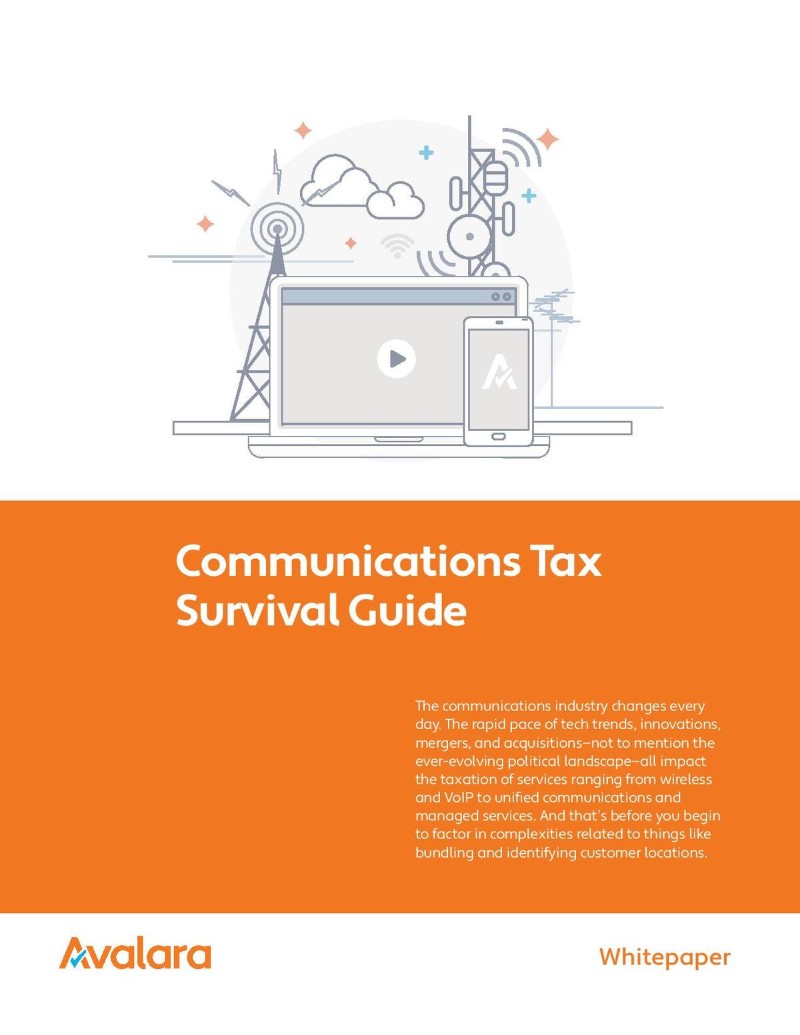Communications Tax Survival Guide | Avalara
Published on 17 Feb 2021

The communications industry changes every day. The rapid pace of tech trends, innovations, mergers, and acquisitions—not to mention the ever-evolving political landscape—all impact the taxation of services ranging from wireless and VoIP to unified communications and managed services. And that’s before you begin to factor in complexities related to things like bundling and identifying customer locations.
It’s no wonder those charged with communications tax responsibility struggle to remain compliant. With more than 12,000 tax jurisdictions in a constant state of flux, the mere act of monitoring all those changes is a full-time job. It can often feel like a struggle to simply survive. And when you’re in survival mode, you need a survival guide. In this white paper, we summarize the top challenges facing communications service providers (CSPs) today, and offer several tactics that can be used to not only survive, but thrive, in their midst.
Communication tax challenges faced by CSPs:
1. Managing Compliance Processes with Complex Nexus
Knowing when nexus is triggered can be difficult for any business. Factor in communications technology where there’s little more than invisible, undetectable radio waves and digital signals to track, and the process of managing compliance across numerous jurisdictions has the potential to become incredibly painful.
2. Keeping up with Rate Changes Across Jurisdictions
In the advancing world of communications, there’s so much more at stake than sales and use tax. Each new communications technology leads to new questions around communications taxes and regulations. How should states respond to this year’s innovations? What will federal agencies regulate next? Which taxes and fees will be applied, and when? Governing bodies are asking these questions and many others like them, and so should CSPs.
3: Avoiding Miscalculations Resulting from Incorrect Locations
In the world of communications taxation, location matters a lot. Pinpointing jurisdictions at the national, state, and local levels can greatly impact compliance with communications taxes and regulations. Including incorrect customer locations on bills can result in underpayments to the appropriate taxing jurisdictions and lead to increased penalties and audit risks. It can also result in tax overpayments and lost revenue.
4. Applying the Right Rates to Bundled Pricing
The implications of continually-changing rates and rules are especially acute when it comes to bundled pricing. As soon as non-taxable services are packaged together with taxable ones, the entire bundle potentially becomes subject to communications taxes and regulatory fees. However, there are effective strategies to unbundle or allocate taxes across services with lower risk. For example, a company might separate out each component of a bundle on the invoice—as though it was sold à la carte style—and apply the appropriate communications taxes to each item on the bill. With proper preparation, the CSP may be able to charge one consistent price on the bills sent to customers while internally separating out each piece for taxation purposes. Whether a provider chooses one of these options or pays full tax on the entire bundle, compliance will require constant research, validation, and updating of tax rates across states—not to mention maintaining meticulous usage records to justify unbundling methods to an auditor.
Avalara, helps CSPs address these challenges with the help of specialized compliance experts, professional services, and an automation platform that supports geo-coding, unbundling, and more through their financial resources. Download their white paper to learn more about the challenges with Communication Tax calculation and how you can deal with them. For more whitepapers
